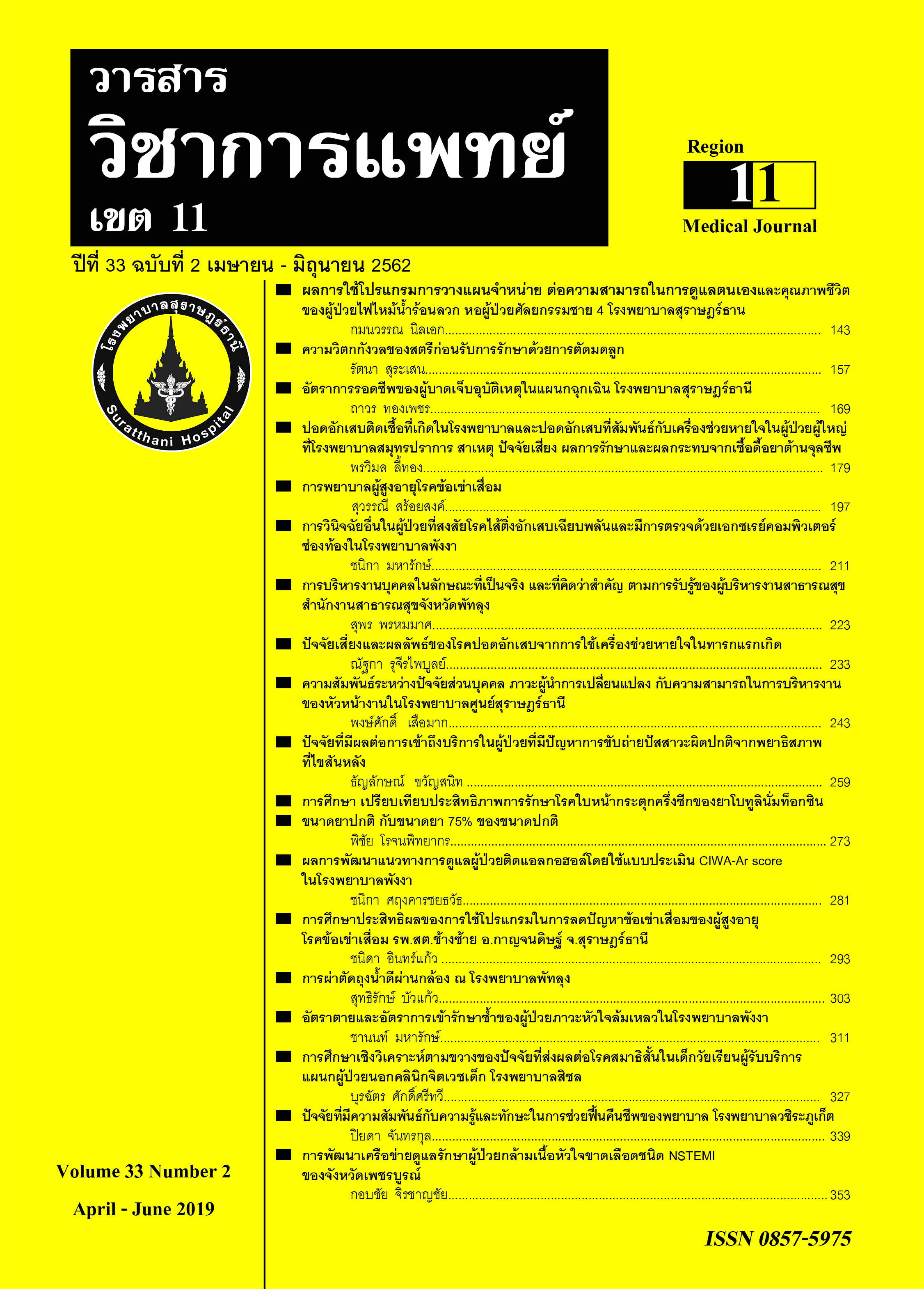Factors affecting access to care in people with neurogenic lower urinary tract dysfunction (NLUTD) from spinal cord lesion
Keywords:
urological care, neurogenic lower urinary tract dysfunction, spinal cord lesionAbstract
Objective: To study factors affecting the access to urinary care for people with spinal cord lesions who have neurogenic lower urinary tract dysfunction (NLUTD).
Methods: This was a retrospective cohort study collecting data from medical records of people with spinal cord lesions with NLUTD who received both out-and in-patients care at Suratthani hospital between October 1, 2015, and September 30, 2016. The data was analyzed using Chi-square statistics and t-test to determine the association between gender, age, home, time to diagnosis of NLUTD, previous visits at the rehabilitation department, the present method of urination and the access to standard urinary care.
Results: Of the 140 people included, 85% were men. The mean duration from spinal cord lesions to being diagnosed with NLUTD was 49 months. Most (42.1%) needed indwelling catheterization with 7.1 % of all sample developed upper urinary tract complications after lower urinary tract dysfunction. About 35% of the sample received proper care at the first evaluation and subsequent follow-ups. Participants who were diagnosed with NLUTD for two years or more, and participants who have visited the rehabilitation department were more likely to received proper standard urinary care.
Conclusion: The duration before being diagnosed with NLUTD and having visited the rehabilitation department increased the likelihood of receiving proper standard urinary care for patients with NLUTD.
References
2. Ginsberg D. The epidemiology and pathophysiology of neurogenic bladder. Am J Mang Care. 2013; 19:191-196.
3. Ruffion A, Castro-Diaz D, Patel H, Khalaf K, Onyenwenyi A, Globe D, et al. Systematic Review of the Epidemiology of urinary incontinence and detrusor overactivity among patients with neurogenic overactive bladder. Neuroepidemiology. 2013; 41: 146155.
4. Meng NH1, Lo SF, Chou LW, Yang PY, Chang CH, Chou EC. Incomplete bladder emptying in patients with stroke: is detrusor external sphincter dyssynergia
a potential cause? ArchPhys Med Rehabil. 2010 ;91(7):1105-9
5. Murphy KP1, Boutin SA, Ide KR. Cerebral palsy, neurogenic bladder, and outcomes of lifetime care. Dev Med Child Neurol. 2012;54(10):945-50.
6. Betts CD, D’Mellow MT, Fowler CJ. Urinary symptoms and the neurological features of bladder dysfunction in multiple sclerosis. Journal of Neurology, Neurosurgery, and Psychiatry. 1993; 56: 245-250.
7. Linsenmeyer TA. Neurogenic bladder following spinal cord injury. In: Kirshblum S, Campagnolo DI ed. Spinal Cord Medicine 2nd edition. Philadelphia 2011. P232-36.
8. Thongchim C, Tamnanthong N, Arayawichanont P. Prevalence of vesicoureteric reflux in neurogenic bladder dysfunction patients from spinal cord lesion. J Thai Rehabil Med. 2010; 20(2): 52-57.
9. Burki JR1, Omar I1, Shah PJ1, Hamid R1. Long-term urological management in spinal injury units in the U.K. and Eire: a follow-up study.Spinal Cord. 2014
;52(8):640-5.
10. Kovindha A. Spinal Cord Injury: Rehabilitation Guidelines for Neurogenic Bladder Dysfunction. Chiang Mai 2005.
11. Pongboriboon P, Tongpraset S, Kovindha A. Quality of life in persons with spinal cord injury: a comparative study between those with indwelling catheterization and intermittent catheterization. J Thai Rehabil Med 2011; 21(1): 13-20.
12. Consortium for Spinal Cord Medicine. Bladder management for adults with spinal cord injury: A clinical practice guideline for health-care providers. Paralyzed Veterans of America 2006.
13. Kuo HC, Chen SL, Chou CL, Chuang YC, Huang YH, Juan YS, et al. Taiwanese Continence Society clinical guideline for diagnosis and management of neurogenic lower urinary tract dysfunction.Urological Science. 2014; 25: 35-41.
14. Abrams P, Agarwal M, Drake M, El-Masrit W, Fulford S, Reid S, et al. A proposed guideline for the urological management of patients with spinal cord injury. BJU international. 2008; 101: 989-994.
15. Lai EC1, Kao Yang YH, Kuo HC. Complication rate of neurogenic lower urinary tract dysfunction after spinal cord injury in Taiwan. Int Urol Nephrol. 2014 ;46(6):1063-71.
16. Kovindha A. Textbook of Spinal Cord Injury: Comprehensive Rehabilitation. Chiang Mai 2013.






